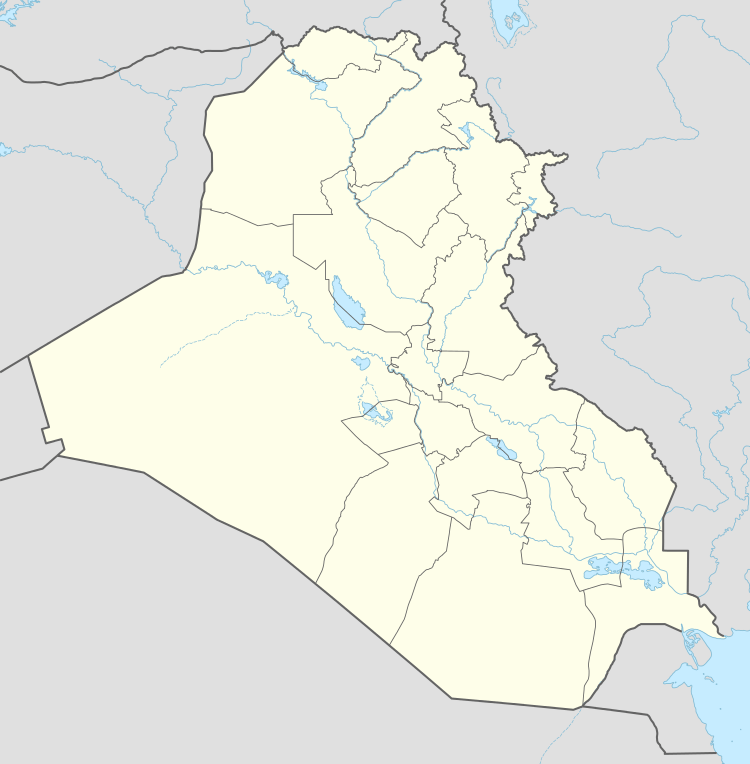Baqofah
Baqofa (also, Baqofah or Bakofa or Bakopa or Baqopa) (Syriac: ܒܝܬ ܩܘܦܐ)[1] is an Assyrian village in northern Iraq located near Batnaya. Most of its inhabitants are adherents of the Chaldean Catholic Church.[2][3] The town was liberated from ISIL by Peshmerga in 2016.[4]
Baqofa | |
|---|---|
 Baqofa | |
| Coordinates: 36°35′20″N 43°7′50″E | |
| Country | |
| Governorate | Nineveh |
| District | Tel Kaif |
| Population | |
| • Total | 1,000 |
| Time zone | GMT +3 |
Etymology
The village's Syriac name may derive from "Beth Qopa" or "Beth Qofa", signifying either the "House of Rods" or "Place of the Skull."[5]
History
The area is believed to have been settled for thousands of years, dating back to the Assyrian Empire era; in 1852, an archaeological dig uncovered artifacts with Cuneiform script.[5] The earliest historical reference to the village dates to the 7th century, in Life of Rabban Hormizd the Persian.[6] Notable historical events have included devastating raids by Mongols in 1436 and 1508, an attack by Persian king Nader Shah in 1743, and an attack launched under order of the Kurdish governor of Rawandz in 1833.[5] An 1852 document indicated that in 1850 approximately families residing in the village attended its single church.[7]
Notable author and bishop Jacques-Eugene (Ogein) Manna, also known as "Ya'qob Awgin Manna",[6] whose Aramaic-Arabic Dictionary was first published in 1900 and was reprinted as recently as 2006,[8][9] was born in the village in 1867.[10][11]
Modern village
The modern agricultural village consists of about 80 brick, cement or stone houses, with approximately 1,000 inhabitants. The population of Baqofah are all Assyrian followers of the Chaldean Catholic Church who speak Neo-Aramaic.[5]
References
- Rowe, Paul (1902). The Histories of Rabban Hôrmîzd the Persian and Rabban Bar-ʻIdtâ.
- "Baqofa". Baqofa.com. Archived from the original on 5 April 2009. Retrieved 2009-04-18.
Baqofa is a Chaldean village located 15 miles north east of Mosul and less than two miles from the village of Batnaya, its roots goes back to the Assyrian era.
- Father Habib.H.AL. Noufaly. Baqofah a Grain of Mustard. Baghdad,Iraq, ST George Chaldean Church, 2002. Chapter1, Page 9, first paragraph says, Baqofah is a Chaldean village. See http://www.baqofa.com/forum/upload/Sarmad/2006-01-17_165158_seed2.bmp.
- "Assyria: take a peek inside a Christian village on the frontlines with Daesh". Al Bawaba. Retrieved 19 December 2019.
- "Baqofa". Baqofa.com. Archived from the original on 5 April 2009. Retrieved 2009-04-18.
- Wilmshurst, David (2000). The Ecclesiastical Organisation of the Church of the East, 1318-1913: Subs. 104. Peeters Publishers. p. 238. ISBN 90-429-0876-9.
- Badger, George Percy (1852). The Nestorians and their rituals. 2. Masters. p. 153.
- Luxenberg, Christoph (2007). The Syro-Aramaic reading of the Koran: a contribution to the decoding of the language of the Koran. Verlag Hans Schiler. p. 21. ISBN 3-89930-088-2.
- Manna, Eugene (2006). Chaldean-Arabic Dictionary. Gorgias Press, LLC. ISBN 1-59333-552-0.
- "Manna, Eugene. Chaldean-Arabic Dictionary". Gorgiaspress. Retrieved 2009-04-15.
- "Bishop Jacques-Eugene Manna". Catholic-Hierarchy.org. David M. Cheney. Retrieved 21 January 2015.
